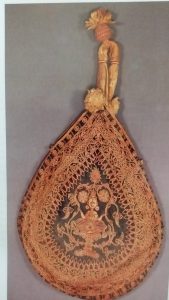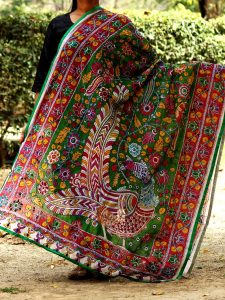By Dr.Lopamudra Maitra Bajpai/newsin.asia
Come winter, the quilting tradition of South Asia comes into the limelight and a significant aspect of that is the Kantha tradition.
Traditionally, the word Kantha refers to a specific type of quilt- sewn together with cotton and soft and used sarees and dhotis.
Coming from Bengal (which includes West Bengal in India and Bangladesh) and parts of Bihar and Jharkhand in India, this cultural heritage was typically handed down from generation to generation, or more precisely, from mother to daughter.
But fortunately, the Kantha tradition has stayed alive over centuries.
Once upon a time a heavily embroidered Kantha also formed a wedding trousseau of a Bengali bride.
Traditionally, Kantha signified quilts or bedspreads or even sheets for infants and newborn babies. As they were sewn together from old clothes- they were extremely soft and comfortable and very suitable for babies.
A nicely padded one, with several layers of cloth, can also make a thick quilt for the winter.
Over the years, the embroidery of a Kantha quit has carved out a niche for itself. Known because of its ubiquitous and traditional running-stitches, a Kantha has heavy embroidery.
The beauty of a Kantha lies in the rich embroidery. Kantha is done through running-stitches. Both long and short running stitches are used.
Traditionally, the threads were carefully separated and pulled out from old sarees. As tradition is so intrinsically connected with the running-stitch, the latter is referred to simply as a ‘Kantha stitch’.

Kantha In Sri Lanka
A close study of a collection of old, cloth and traditional bulath bags, which are cloth bags or pouches used to carry betel leaves and also sometimes the accompanying betel nuts, chunam paste, etc, will show Sri Lanka’s connection with India. These bags can be seen in the Colombo National Museum.
Kantha stitches can be seen in both the long and short versions in the bulath bags of Sri Lanka. These date between 17 th. and early 19 th. centuries and were found in Kandy during the reign of the indigenous kings there before the British took over Kandy in 1815.
Away from the shores of the Indian Ocean, Kantha stitches can also be seen in the exquisite creations of Nepal. These bear a close resemblance to the Sujani Kantha of Bihar and Jharkhand in India.
In a typical Sujani Kantha embroidary, the running stitches are worked in a straight line. But in a typical and traditional Kantha, these stitches are used mostly in a spiral or circular or conical forms.
In a Sujani Kantha, the outline of the motifs is done by chain-stitches in dark color but in a Kantha, all the stitches, including the borders, are done in running stitch.
Across Bengal, Kantha are of about seven types. All seven types are found in the region. The seven types are:

Sujani – heavy embroidered quilts- often requiring several months to make. Lep– Entire pieces of rectangular cloths sewed over rippled designs. Baiton– mostly used as book covers. Durjani/Thalia– with a lotus design at the centre and used to make wallets. Arshilata– small and rectangular covers for mirrors or toilet accessories, with wide colorful borders in assorted motifs. Ooar– small pillow covers with embroidered borders. Rumal– embroidered handkerchief with a central lotus motif with ornamented borders.
Prof. Stella Kramrisch took the Kantha and its concept out of Bengal. She taught at Kala Bhavan in Santiniketan and later at the University of Pennsylvania. She had Kanthas with Hindu iconography in her collection.
Nakshi Kantha quilts emanated from various regions of present-day Bangladesh. The famous poem- Nakshi Kantha in Bangla by renowned poet Jasimuddin from Bangladesh speaks of a story of love, grief and remembrance and the story is told through a heavily embroidered quilt- a Nakshi Kantha.
Niaz Zaman mentions in the book- The Art of Kantha Embroidery (Dhaka, The University Press. 1981) a story by Abanindranath Tagore, in which a poet wanders off to a remote village and meets an old widow who was sewing a Kantha portraying her life’s events on it, from her wedding onwards.
Over the years, the Kantha has also found an echo in various forms of popular culture, including television programs and stage dramas.
In the last hundred years, several attempts at the popularisation of the Kantha stitch has resulted in the embroidery finding its way into various articles of daily use, including sarees, bags, pillow covers, bedspreads and other household articles. But only time will tell whether the Kantha stitch will fade with time or will continue to hold its own in the world of art and culture in South Asia.
(The featured image at the top shows a Kantha embroidered quilt for export)























































